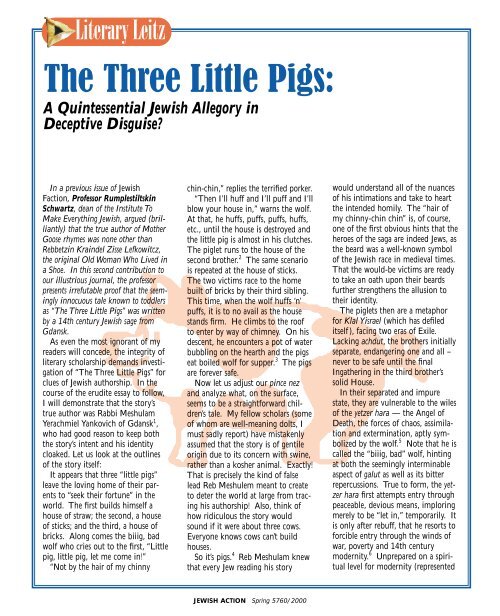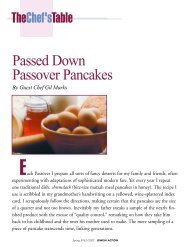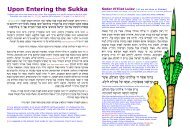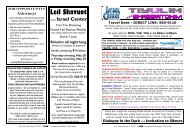You also want an ePaper? Increase the reach of your titles
YUMPU automatically turns print PDFs into web optimized ePapers that Google loves.
Literary Leitz<br />
<strong>The</strong> <strong>Three</strong> <strong>Little</strong> <strong>Pigs</strong>:<br />
A Quintessential Jewish Allegory in<br />
Deceptive Disguise?<br />
In a previous issue of Jewish<br />
Faction, Professor Rumplestiltskin<br />
Schwartz, dean of the Institute To<br />
Make Everything Jewish, argued (brilliantly)<br />
that the true author of Mother<br />
Goose rhymes was none other than<br />
Rebbetzin Kraindel Zisse Lefkowitcz,<br />
the original Old Woman Who Lived in<br />
a Shoe. In this second contribution to<br />
our illustrious journal, the professor<br />
presents irrefutable proof that the seemingly<br />
innocuous tale known to toddlers<br />
as “<strong>The</strong> <strong>Three</strong> <strong>Little</strong> <strong>Pigs</strong>” was written<br />
by a 14th century Jewish sage from<br />
Gdansk.<br />
As even the most ignorant of my<br />
readers will concede, the integrity of<br />
literary scholarship demands investigation<br />
of “<strong>The</strong> <strong>Three</strong> <strong>Little</strong> <strong>Pigs</strong>” for<br />
clues of Jewish authorship. In the<br />
course of the erudite essay to follow,<br />
I will demonstrate that the story’s<br />
true author was Rabbi Meshulam<br />
Yerachmiel Yankovich of Gdansk 1 ,<br />
who had good reason to keep both<br />
the story’s intent and his identity<br />
cloaked. Let us look at the outlines<br />
of the story itself:<br />
It appears that three “little pigs”<br />
leave the loving home of their parents<br />
to “seek their fortune” in the<br />
world. <strong>The</strong> first builds himself a<br />
house of straw; the second, a house<br />
of sticks; and the third, a house of<br />
bricks. Along comes the biiig, bad<br />
wolf who cries out to the first, “<strong>Little</strong><br />
pig, little pig, let me come in!”<br />
“Not by the hair of my chinny<br />
chin-chin,” replies the terrified porker.<br />
“<strong>The</strong>n I’ll huff and I’ll puff and I’ll<br />
blow your house in,” warns the wolf.<br />
At that, he huffs, puffs, puffs, huffs,<br />
etc., until the house is destroyed and<br />
the little pig is almost in his clutches.<br />
<strong>The</strong> piglet runs to the house of the<br />
second brother. 2 <strong>The</strong> same scenario<br />
is repeated at the house of sticks.<br />
<strong>The</strong> two victims race to the home<br />
built of bricks by their third sibling.<br />
This time, when the wolf huffs ‘n’<br />
puffs, it is to no avail as the house<br />
stands firm. He climbs to the roof<br />
to enter by way of chimney. On his<br />
descent, he encounters a pot of water<br />
bubbling on the hearth and the pigs<br />
eat boiled wolf for supper. 3 <strong>The</strong> pigs<br />
are forever safe.<br />
Now let us adjust our pince nez<br />
and analyze what, on the surface,<br />
seems to be a straightforward children’s<br />
tale. My fellow scholars (some<br />
of whom are well-meaning dolts, I<br />
must sadly report) have mistakenly<br />
assumed that the story is of gentile<br />
origin due to its concern with swine,<br />
rather than a kosher animal. Exactly!<br />
That is precisely the kind of false<br />
lead Reb Meshulem meant to create<br />
to deter the world at large from tracing<br />
his authorship! Also, think of<br />
how ridiculous the story would<br />
sound if it were about three cows.<br />
Everyone knows cows can’t build<br />
houses.<br />
So it’s pigs. 4 Reb Meshulam knew<br />
that every Jew reading his story<br />
would understand all of the nuances<br />
of his intimations and take to heart<br />
the intended homily. <strong>The</strong> “hair of<br />
my chinny-chin chin” is, of course,<br />
one of the first obvious hints that the<br />
heroes of the saga are indeed Jews, as<br />
the beard was a well-known symbol<br />
of the Jewish race in medieval times.<br />
That the would-be victims are ready<br />
to take an oath upon their beards<br />
further strengthens the allusion to<br />
their identity.<br />
<strong>The</strong> piglets then are a metaphor<br />
for Klal Yisrael (which has defiled<br />
itself), facing two eras of Exile.<br />
Lacking achdut, the brothers initially<br />
separate, endangering one and all –<br />
never to be safe until the final<br />
Ingathering in the third brother’s<br />
solid House.<br />
In their separated and impure<br />
state, they are vulnerable to the wiles<br />
of the yetzer hara — the Angel of<br />
Death, the forces of chaos, assimilation<br />
and extermination, aptly symbolized<br />
by the wolf. 5 Note that he is<br />
called the “biiig, bad” wolf, hinting<br />
at both the seemingly interminable<br />
aspect of galut as well as its bitter<br />
repercussions. True to form, the yetzer<br />
hara first attempts entry through<br />
peaceable, devious means, imploring<br />
merely to be “let in,” temporarily. It<br />
is only after rebuff, that he resorts to<br />
forcible entry through the winds of<br />
war, poverty and 14th century<br />
modernity. 6 Unprepared on a spiritual<br />
level for modernity (represented<br />
JEWISH ACTION Spring 5760/2000
y their flimsy protection), the scattered<br />
ones are vulnerable to his<br />
attack. It is only through<br />
Providence, evidenced by the uncanny<br />
feat of a couple of pigs outrunning<br />
a wolf, that that they are not<br />
entirely lost.<br />
<strong>The</strong> final episode, in which the<br />
first two little pigs do teshuvah and<br />
rejoin their wise, patient brother —<br />
who remained throughout the centuries<br />
steadfast in his brick-solid<br />
beliefs — is one of the most<br />
poignant in pig-literature. 7 By<br />
means of this touching reunion, the<br />
yetzer hara is boiled and served on<br />
toast, never again to be a threat to<br />
the world. A masterful messianic<br />
touch on the part of Reb Meshulem!<br />
Anyone who can still deny that<br />
this allegory was written by a Jew<br />
should reread my article until he is<br />
convinced. One more note of historical<br />
interest: It has been conjectured,<br />
not unreasonably, that the<br />
original story was about <strong>Three</strong> <strong>Little</strong><br />
Figs, but a printer’s error in the<br />
Hebrew transliteration added an<br />
unfortunate dagesh, rendering the<br />
story forevermore about pigs. It<br />
boggles the mind to think of the layers<br />
of meaning inherent in the story,<br />
should this legend be true. But that,<br />
of course, is an essay for another<br />
time.<br />
Notes:<br />
1. Most people from Gdansk are, of<br />
course, guarded when it comes to publicizing<br />
their birthplace – missing a vowel,<br />
as it is.<br />
2. O.K., I’m aware that there are other<br />
versions of this story in which the pigs<br />
are actually consumed by the wolf. But<br />
that would wreck my whole thesis, so<br />
I’m ignoring them.<br />
3. In some accounts, the pigs repeatedly<br />
do a little jig and sing, “Who’s afraid of<br />
the big, bad wolf?” but this is a fabrication<br />
added in the modern era by obtuse<br />
people who would destroy true meaning<br />
for the sake of including a stupid song!<br />
This is fairy tale revisionism in its most<br />
vile form. I disdain it.<br />
4. Reb Meshulem obviously belonged to<br />
the school of thought that held that pigs<br />
are kosher for literary allegorical<br />
purposes. Few people besides me know<br />
that this was a fierce rabbinic battle raging<br />
in Gdansk at the time. So Reb<br />
Meshulem was making a statement,<br />
indeed a psak, about the use of treif animals<br />
in literature through this story.<br />
5. Note here that that the distinguished<br />
Rabbi Akiva (who was not as literary as<br />
I, but a very good fellow) utilized a wolf<br />
to symbolize the very same forces of evil<br />
and assimilation inherent in the Roman<br />
Empire in his parable of the wolf who<br />
tries to entice the fishes to jump onto<br />
dry land. No, wait. That was a fox.<br />
Well, you get the idea, anyway.<br />
6. Each huff and puff actually represents<br />
an economic downturn or an anti-<br />
Semitic act, but you’d have to know<br />
Gdansk history to appreciate it. See my<br />
dazzling essay, “Istoricalhay Ecretsay foay<br />
Danskgay,” published in the Journal of<br />
Literary Conjecture and Inapplicable<br />
Knowledge, vol. 623, no 4, pp. 18-295.<br />
7. In contrast, see my inspired analysis<br />
of the hedonistic little piggies who went<br />
to market, stayed home and ate roast<br />
beef. New Journal of Irrelevant<br />
Scholarship vol.17, no. 5, pp. 11-95.<br />
NEW!<br />
HAMOTZI<br />
All Ten Words<br />
Available in leather-bound<br />
Deluxe Edition<br />
From ArtScrawl<br />
HAMOTZI All Ten Words!<br />
Genukshoin Edition<br />
Understand the Brachah on the Staple of Life!<br />
<strong>The</strong> Most Famous Blessing in the World!<br />
Translated...Transliterated...Annotated...Commentated<br />
With an Overview, Underview, and Aerial View<br />
written by real rabbis!<br />
Transliteration<br />
Commentary<br />
LECHEM<br />
bred<br />
<strong>The</strong> eighth <strong>The</strong> word’s<br />
word of the position in the<br />
brachah carries brachah, therefore,<br />
comes<br />
unusual significance<br />
being, after the most<br />
as previously important<br />
noted, eighth. word-hamotzi-<br />
Eight is, after [see commentary<br />
all, greater on previous<br />
than seven. page], signifying<br />
OJK<br />
bread<br />
monumental<br />
significance,<br />
according to<br />
our Sages. A<br />
point of controversy,<br />
raised<br />
by generations<br />
of poskim,<br />
over whether<br />
or not the<br />
Italian breadstick<br />
is, in fact,<br />
a form of<br />
bread worthy<br />
of the blessing,<br />
or whether it is<br />
a cracker. <strong>The</strong><br />
presence of<br />
sesame seeds,<br />
however, might<br />
Hebrew<br />
Translation<br />
JEWISH ACTION Spring 5760/2000
















